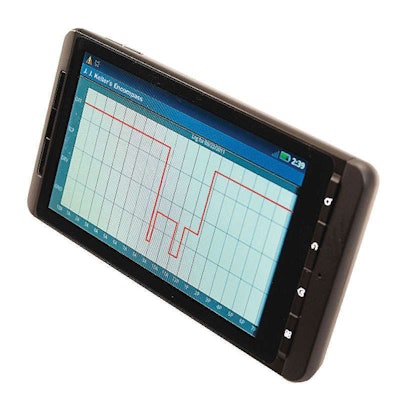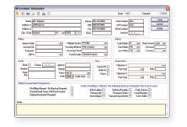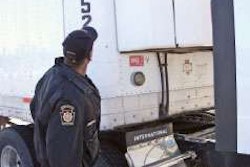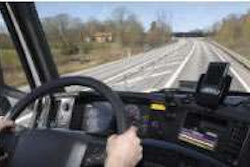Mobility on speed dial
Smartphones expand technology options
Smartphones are spreading like wildfire throughout the transportation industry. Executives, managers and drivers are consuming new apps that increase their connectivity and productivity.
 J.J. Keller offers an onboard recorder for $199 that is compatible with Android smartphones to record hours of service and driver vehicle inspection reports.
J.J. Keller offers an onboard recorder for $199 that is compatible with Android smartphones to record hours of service and driver vehicle inspection reports.The cloud computing model – a network of remote servers hosted on the Internet – quickly has become the mainstream for how businesses choose to process, store and manage their data. The power and affordability of today’s consumer devices and cloud computing have opened a wide menu of options for deploying new technology using a wide range of compatible devices, wireless services and apps that meet specific needs.
Electronic logs
A major consideration of using smartphone technology is what to do about electronic driver logs. Due to recent rule changes, electronic logs increasingly have become necessary to avoid common mistakes and penalties associated with using paper logbooks.
Giving smartphones to drivers can be a cost-effective way to fulfill a need, such as automating driver messaging or capturing pickup-and-delivery details. But if deploying a U.S. Department of Transportation-compliant electronic onboard recorder also is on your priority list, the range of options narrows.
J.J. Keller offers an onboard recorder for $199 that is compatible with Android smartphones to record hours of service and driver vehicle inspection reports through its Encompass E-Logs online reporting service, which starts at $3 per month.
By upgrading to the Encompass Compliance Edition for $6.50 per month, fleets can use an expanded set of compliance tools for vehicle maintenance, a Compliance Safety Accountability dashboard and BASICs management. The Encompass Premium Edition is $25 per month and includes a performance dashboard with fuel usage, GPS location tracking and other driver metrics.
Greg Gossler, safety and compliance manager for Hercules Transport – a Choudrant, La.-based hazmat hauler – says J.J. Keller’s onboard recorder and Encompass system have improved his company’s compliance and dispatch efficiency.
A wide range of compatible devices, wireless services and apps meet specific needs.
“We now have the capability to give a driver his dispatch over a handheld,” Gossler says. “We wanted something to be able to tell a driver that ‘Your dispatch has changed. You don’t need to leave at 6 a.m. as you were previously told. You need to leave at 3 a.m. ”
Xata Turnpike’s RouteTracker service combines DOT-approved electronic logs with GPS tracking, engine diagnostic reporting and electronic driver inspections for $35 per month. A small device captures satellite tracking and engine data from the vehicle and connects to a mobile app on devices using Bluetooth.
Signing off
Another example of how smartphone apps can lower IT costs is with electronic proof of delivery and signature capture.
PCS Software recently announced the Mobile XpressTrax iPhone interface for its dispatch and transportation management software system, Express. The interface is used by drivers to automate dispatch messaging and to check calls and status updates for loads. The app includes electronic signature capture for proof of delivery and document imaging.
JumpTech has been offering software to capture signatures and proof-of-delivery information since 2003. Until last year, its customers were using industrial-grade handheld devices. With a new app released last year called JumpTrack, its proof-of-delivery system can be run in a smartphone environment.
JumpTrack runs on the Apple iOS and Android platforms. The Office City – a Redwood City, Calif.-based supplier and distributor of office products – was the first JumpTech customer to migrate to this new mobile environment.
“The cost per truck with JumpTrack is 80 percent less than traditional terminal solutions, and the turn-up time for new trucks is reduced from two weeks to just a few hours,” says Jerry Carroll, chief financial officer and vice president of operations for The Office City.
JumpTrack can interface with fleets’ transportation management systems. Through this interface, delivery manifest data is pulled into the cloud and into the mobile app on each smartphone. The delivery information received by the driver is specific to his daily route.
 Aaron Huff is Senior Editor of Commercial Carrier Journal. E-mail [email protected] or call (801) 754-4296.
Aaron Huff is Senior Editor of Commercial Carrier Journal. E-mail [email protected] or call (801) 754-4296.When a driver logs into the mobile app, he sees a list of planned delivery stops. After arrival, the driver verifies package count and can take a picture of any damage, as well as capture a signature from the customer directly onto the phone. The captured data is sent back to the cloud in real time and made available through integration with a TMS system or by using the JumpTrack Web portal.
Many fleets always will prefer using computing platforms that are fixed to their vehicles for the added reliability and security. But considering the low cost and added flexibility of today’s smartphone apps and cloud computing, the tradeoffs may be worth it.
In the cloud, all around.
Cloud computing, smartphones broaden options.
Economical tracking.
Fleets can deploy electronic logs for a low monthly cost.
Technology on the go.
Mobile delivery apps enable real-time invoicing.
InBrief
OnAsset Intelligence, a provider of machine-to-machine wireless asset tracking, sensing and control systems, announced that its relationship with Sprint has produced a dual-mode CDMA/GSM asset-tracking solution for global use.
Pegasus TransTech introduced Transflo Now Mobile for Android phones, a scanning solution designed to speed document delivery.
Fleet One, a provider of fuel cards and fleet-related payment systems, announced that Hess Corp. extended its current multiyear fleet services agreement until 2019. Fleet One will continue to be the issuer and processor of Hess’ branded fleet fueling card.
Vigillo announced that its latest CSA Scorecards incorporate advanced Driver Essentials designed to emphasize driver impact and enable users to take full advantage of the company’s Compliance Safety Accountability reporting system.
Arsenault Associates, provider of Dossier fleet asset maintenance management software, named Jack Boetefuer chief executive officer after Charles Arsenault’s retirement.
Getloaded, an Internet-based logistics load board company, announced a new Web services interface designed for high-volume customers that integrates customers’ systems directly into the Getloaded network.
Stevens Transport, a Dallas-based refrigerated carrier, selected Qualcomm’s Mobile Computing Platform 200 to integrate across its fleet of about 2,000 tractors.
PCS Software expands interfaces with Qualcomm, PeopleNet
PCS Software announced a trio of new enhancements for Express, its transportation management software, that incorporate upgrades to interfaces with Qualcomm and PeopleNet satellite tracking services:
 PCS Software’s enhancements for its Express transportation management software incorporate upgrades to interfaces with Qualcomm and PeopleNet satellite tracking services.
PCS Software’s enhancements for its Express transportation management software incorporate upgrades to interfaces with Qualcomm and PeopleNet satellite tracking services.• PCS Proximity Tracking interfaces with PeopleNet’s Pacos and Qualcomm’s Circle of Service to alert shippers, consignees and customers when a driver reaches a certain radius of the pickup or delivery location, eliminating the need for phone calls for proximity notification;
• HOS (Hours of Service) Tracking provides real-time updates on available on-duty and driving hours for Qualcomm- and PeopleNet-enabled drivers; and
• In Cab Scanning allows for scans to be transmitted through Qualcomm and PeopleNet and inserted automatically into a fleet’s database to allow for rapid invoicing.
PCS says these augmentations to its interface partners will help its transportation clients reach new levels of productivity while saving time and operating expenses.
New software help
Pluss Corp. (www.pluss.net), a Montana company that focuses exclusively on the aftermarket parts and repair industry and has a large following in the heavy-duty industry, announced ePluss, a migration service for larger heavy-duty businesses moving from older, obsolete business systems to newer Windows-based software. Pluss says ePluss is a streamlined five-step process best suited for larger truck or heavy-duty businesses that need to move to a new business system.
In Focus: Document Management
Picture perfect
Technology expands options for converting paperwork to cash
By Aaron Huff
Billing within 24 hours of delivery – even if shippers and brokers require document submission –has become a critical necessity. To get fast turnaround, bills of lading and other receipts can be captured remotely through a variety of methods: overnight drop box service, truckstop scanning, in-cab scanning on company computers and by using personal laptops and smartphones.
 ACS TripPak Services document management products includes overnight drop boxes, truckstop scanning, central scanning, in-cab scanning and smartphone capture.
ACS TripPak Services document management products includes overnight drop boxes, truckstop scanning, central scanning, in-cab scanning and smartphone capture.Technology providers now offer more options than ever. Pegasus TransTech, which offers Transflo Express truckstop scanning, quickly recognized how mobile scanning was catching fire among drivers with compatible personal devices and developed applications for scanning from a laptop, PC or smartphone to mirror its truckstop scanning functionality.
However, using multiple sources to capture images can create some technical barriers; in some cases, the images and “meta” data used to identify and index may be in different formats. Technology providers recently have added new features to address this challenge.
Forms recognition
To eliminate manual processing of scanned images sent by drivers, many fleets have adopted automatic forms recognition and indexing; drivers simply submit a cover sheet or affix barcodes to documents before scanning for identification.
Once the images reach the office, the software identifies the document type – such as a bill of lading, weight ticket or toll receipt, as well as indexing information by driver, truck, trip, customer, etc. – to match the image to the correct order in the dispatch and accounting system.
McLeod Software expanded the set of barcode capabilities in version 10 of DocumentPower. The software can auto-index a broad range of electronic images that come from any source via the Web, e-mail and remote scanners. A new Web scanning and indexing application allows users to include a link to the application on their company Website for drivers, agents and carriers to access from any device to scan and submit documents.
EBE Technologies recently added several new features to its Ships document management system that can convert incoming images or files into compatible formats for its auto-indexing module. If a driver sends an e-mail with an image attachment from a smartphone, the module could capture the order number from the e-mail’s subject line; the software would index the document by cross-referencing this number with information in a dispatch software system. Another new feature provides immediate feedback to drivers if the images they capture aren’t acceptable quality.
Integrated invoicing
Affiliated Computer Services’ new TripPak Exchange Internet-based imaging system is designed to provide a single platform for carriers to submit invoices, document images and data to customers, factoring companies and other parties directly. Carriers can go online to enter additional information or submit documents based on specific customer requirements.
Shippers and brokers pay a per-document charge for images they receive through TripPak Exchange. Fleets can access the images online for free but pay a per-document charge for images they choose to capture for internal use only, such as toll receipts or logbooks.
The latest developments, combined with an array of capture options, result in an automated process for converting paper and electronic documents into faster cash flow.












